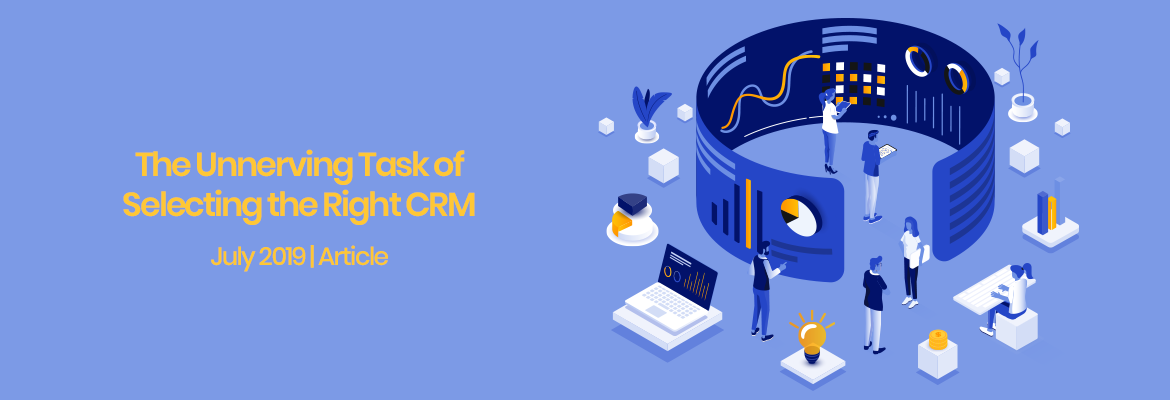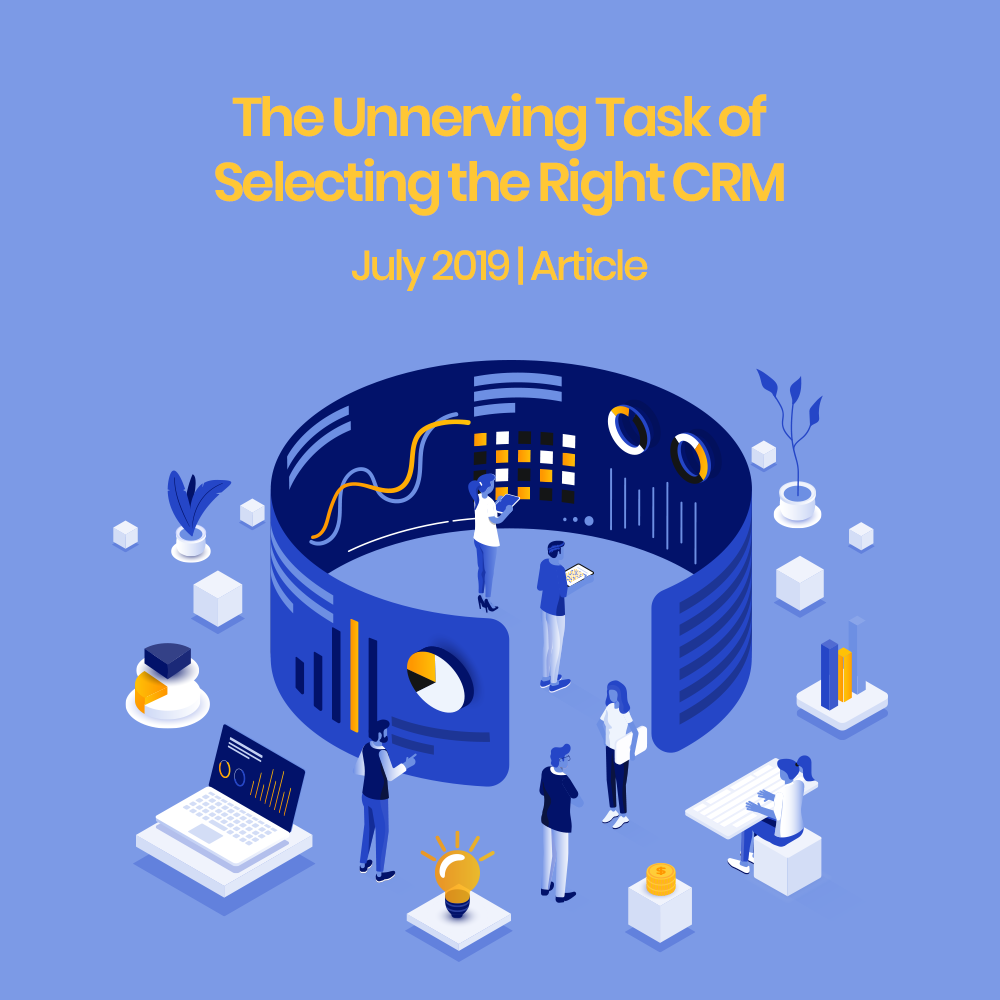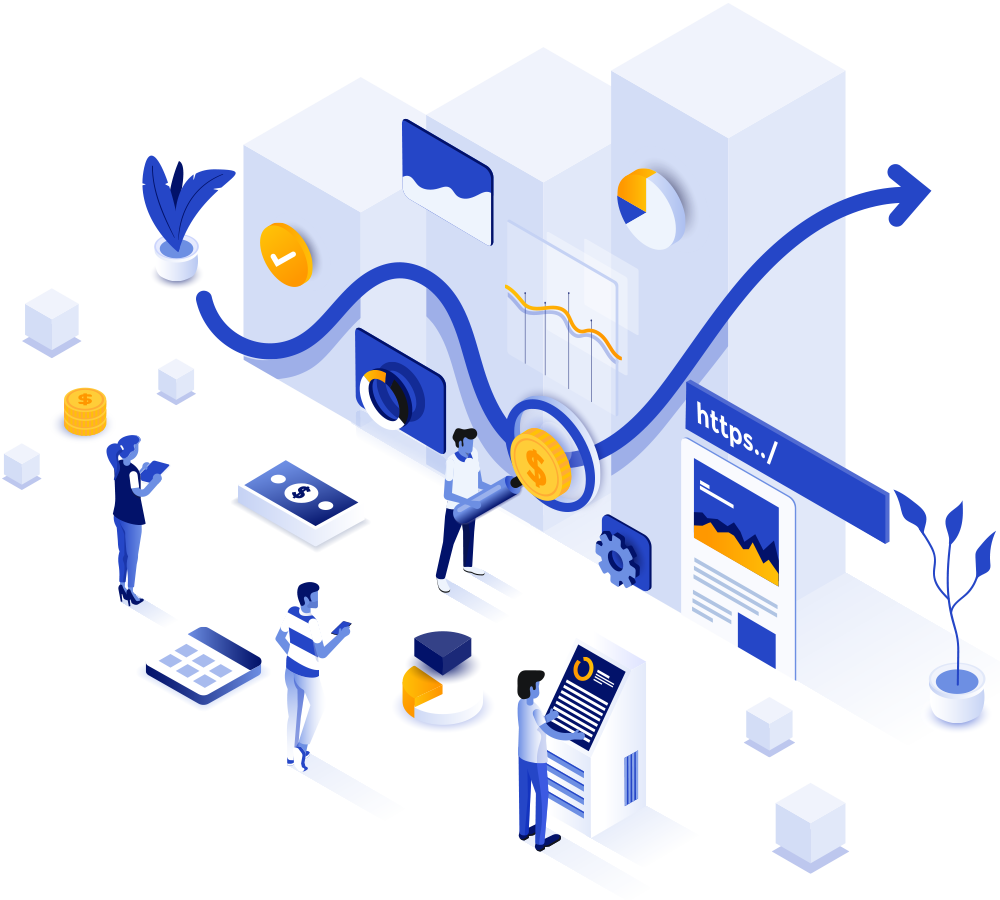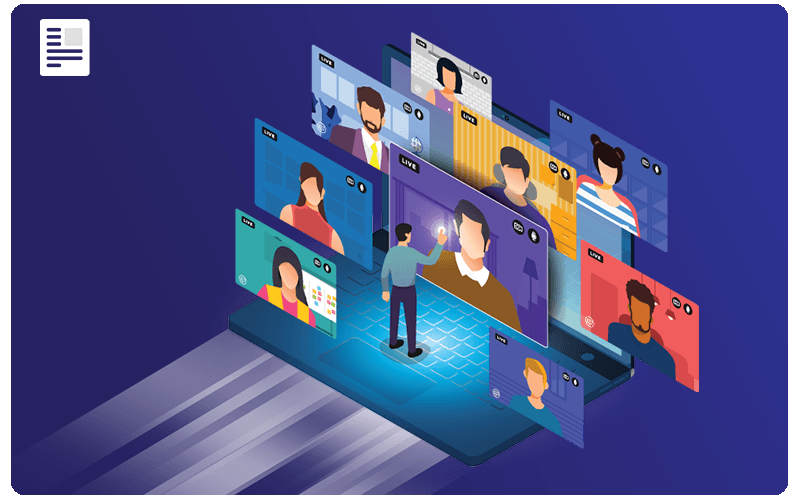

The growing need to form closer customer relationships has made CRM one of the more important enterprise investments of recent times. With features and functions that have direct effects on the top and bottom lines of the business, most executives have either made the investment or are in the process of looking at one or upgrading to one. But the process is hardly easy. There are 100+ CRM solution options available to fit the needs of organizations of every size, industry, and budget and many executives find themselves lost for direction and end up racking millions (yes, dollars) just to figure out the right one. Afterall, every email, social media and CX outfit has some semblance of CRM features baked into their suite and tries to pass up as a bonafide CRM provider to help learn and engage customers better. I guess, one can hardly blame these executives that try to make sense out of these chaotic market forces and map them with their internal struggles of getting their CRO’s, CIO’s, CFO’s, CCO’s and CDO’s on the same page to move ahead with the direction and the investment. While much is to be considered before picking one, the following can provide some perspective.
Buy one or build it in-house
The buy vs. build argument never gets old. Many CIO’s argue that they have built substantial infrastructure that allows in-house consumer-facing tools to provide the level of data and precision that the business needs to engage the customers in the way they please. The business on the other hand fancies the structural processes and the methodical approach that a CRM brings to their sales, service and marketing organizations. While there are pro’s and cons to both sides that stem from dynamics ranging from culture to geography to size to industry, a methodical approach usually wins (or should win) as most IT organizations do not have the experience or the exposure to bake in the type of workflows that CRM systems have in built (or get the types of results offered by the CRM). I guess in most cases, it comes down to the ROI numbers that one can live with (instead of multitude of reasons including value, user experience, etc.) but regardless of the direction that gets chosen, deploying systems that are built around the customer need a vision, change and risk management effort to act as a guide to achieving the goal.
On-premise or cloud
Modern CRM solutions are available in both on-premise and cloud varieties, however, the shift has been to the cloud side for a while now. Cloud CRM spending was up from 12% in 2008 to 75% in 2019 over its on-premise counterpart. The remaining 25% non-clouders equate to regulatory challenges around certain industries and its subsequent data residencies and of course, personal preferences on keeping things in house as well. And while the feature function set is largely similar (with some exceptions), the cloud has been a preferred operating model in the CRM space as its operational flexibility, agility, scalability, and ease of upgrades are a big attraction. Also, going forward, major CRM providers are no longer investing in on-premise architectures as heavily as they once did and are making every effort to move to the cloud, which, can be challenging from a support perspective as with no new investments in on-premise, some of these solutions might be sun-setted (an industry term for retired) in the near future in favor of the cloud. Hence, decisions should be made with a multitude of factors considered.
Sticking with the known stack
Most CIO’s and CTO’s prefer simplified technology stacks and architectures. What this means is that whatever they have already bet on from an enterprise grade technology ecosystem (SAP, Oracle, Microsoft etc.) perspective, they prefer sticking to it for obvious reasons like familiarity, skillset availability etc. In such cases, ERP/Business Intelligence and other operational technology vendors that sell CRM are at an advantage. The integrations and purchasing process is easier, the ROI can be combined and a much better price can be bargained upon. While there are many advantages to this approach (and it’s a preferred approach across the board), leading CRM vendors like Salesforce for instance, argue a much better product, user experience and an ROI for what they offer regardless of other systems in the stack. Microsoft, that offers the complete set of systems offers an even bigger advantage because of its seamless integrations with the Office and Exchange suite. This is not the most important factor to consider, but if all things equal, this can make the decision process easier and things run smoothly in the long run.
Regulations around data & security
For the on premise model, this is a non-issue as internal IT is typically responsible for the security and integrity of the data for the enterprise. On the cloud side, solution providers often argue that they are more secure than any internal IT could possibly be (partly because it’s in their DNA to put a lot of effort on security) and partly because this is thier bread and butter and they have to ensure that its secure for people to buy. This is true in part, though, a Gemalto and Ponemon Institute study reports 3 of 4 IT experts to find privacy and data protection more complicated in off-premises than in on premises systems. Due to local regulatory requirements, compliance (GDPR, Cloud Act) or other sensitivities, these concerns are magnified even further in particular industries (even more than the providers). Government, healthcare, financial services are examples of a few sectors that do not allow data residing outside their premise (and more stricter if its outside the country). In Asia and Middle East, most financial outfits do not allow customer/public data to be hosted on a public cloud and are hence limited to on premise CRM solutions or go with a private or at max, hybrid cloud where clear lines of demarcation are drawn to stay compliant. Compliance-related barriers are big enough to be the third most-commonly cited hurdle to cloud adoption in enterprises, at 26%, according to an (ISC)² report and its CRM version follows the same pattern.
Wall to wall or phased implementations
Wall to wall is a software industry phrase used to describe an organization wide implementation of a solution. In the case of a CRM, it refers to all customer-facing employees (sales, services, and marketing) and their leadership as users of a system that’s typically sold under an Enterprise Level Agreement (a salesperson’s dream). Some clients do choose this route as it enables a complete end to end journey across all touchpoints that are mapped and optimized for ultimate success, but the majority doesn’t go for it right away and prefer a phased one (where they can continue to iteratively learn and add up smaller wins). The Big-Four of the CRM world (Salesforce, SAP, Oracle, Microsoft) offer dedicated modules of Sales, Service and Marketing (Commerce, HR, Supplier and more have been added lately) that can be implemented separately or weaved in as part of one solution where all processes and data flow seamlessly for ultimate customer experience. There are merits on both sides based on the use case, industry and geography.
Ecosystems and third-party integrations
These CRM Big-Four’s come with their ecosystems attached. These Ecosystems allow plug-ins for specific use cases typically not available in the native CRM solution but are built by 3rd party vendors on the same stack and can be purchased and plugged in as add-ons to provide value. This circumvents the need for the client to go outside the domain of the solution to solve such challenges. Travel, HR and other use cases are popular and this is a significant time and cost saver for not only the product acquisition and implementation but also user training (as it conforms to the same system protocols). Industry leader Salesforce, for instance, has its vast AppExchange platform (with over 3600 application ready for instantaneous integration) for providing third-party plug-ins and support. It also integrates seamlessly with G-Suite, Office 365, and MailChimp and the use case can even be extended to Blockchain platforms and applications for advanced futuristic use cases. Similarly, businesses looking to build mixed reality applications can be well-served by Microsoft’s Dynamics 365, which enables the creation of innovative service and marketing use cases through augmented technology.
The right spend & ROI
 Like any other system, much to keep the CFO’s at ease, a lot goes in the cost and ROI calculations of a CRM. For the on-premise versions, one has to factor in the hardware costs of housing the applications and the data in addition to the software. Cloud versions cover these costs in their subscriptions but both types need time, effort and money spent on planning the project, studying risks, putting together teams and governance structures, migrating and integrating data, configuring, customizing, testing and implementing the software, training the people, ensuring security measures with VPN’s and many other activates that add to the total cost of the CRM program. The cost of software alone varies based on the type of CRM being considered as well as its deployment model. For cloud, simple ones can run from under $10 per user per month to the Big Four’s running in the hundreds of dollars per user per month (depending on the version, of the slice of the software one tries to acquire). The cost for these cloud versions is typically measured as a Total Cost of Ownership typically over 1 or 3 or 5 years and is considered an operational expense that is typically spread over the duration of the contract. The on-premise costs are typically higher upfront (as you are buying instead of renting) and a subsequent yearly maintenance fee (that is smaller) is added to the contract and are typically considered capital expenses on the balance sheet. Like costs, ROI estimates also vary depending on the industry, geography, type and size of the organization, the use case, the solution chosen, and the type of implementation styles and implementor chosen. Estimated ROI numbers studied can range from $8 to $24 returns for every $1 spent on CRM (depending on how the data is sliced and diced). Regardless, the value a CRM provides far outweighs the costs associated with it.
Like any other system, much to keep the CFO’s at ease, a lot goes in the cost and ROI calculations of a CRM. For the on-premise versions, one has to factor in the hardware costs of housing the applications and the data in addition to the software. Cloud versions cover these costs in their subscriptions but both types need time, effort and money spent on planning the project, studying risks, putting together teams and governance structures, migrating and integrating data, configuring, customizing, testing and implementing the software, training the people, ensuring security measures with VPN’s and many other activates that add to the total cost of the CRM program. The cost of software alone varies based on the type of CRM being considered as well as its deployment model. For cloud, simple ones can run from under $10 per user per month to the Big Four’s running in the hundreds of dollars per user per month (depending on the version, of the slice of the software one tries to acquire). The cost for these cloud versions is typically measured as a Total Cost of Ownership typically over 1 or 3 or 5 years and is considered an operational expense that is typically spread over the duration of the contract. The on-premise costs are typically higher upfront (as you are buying instead of renting) and a subsequent yearly maintenance fee (that is smaller) is added to the contract and are typically considered capital expenses on the balance sheet. Like costs, ROI estimates also vary depending on the industry, geography, type and size of the organization, the use case, the solution chosen, and the type of implementation styles and implementor chosen. Estimated ROI numbers studied can range from $8 to $24 returns for every $1 spent on CRM (depending on how the data is sliced and diced). Regardless, the value a CRM provides far outweighs the costs associated with it.
Selecting the right CRM: the TransformX way
As this write-up details and suggests, succeeding in a CRM initiative can require a concerted effort and understanding from multiple dimensions of business and IT. The TransformX Customer Success Model assists clients in achieving this by assessing their readiness to take on a CRM implementation and leveraging a methodical, proprietary and industry-leading approach to help select the best fit solution that will add comprehensive value for their customer-related goals. The processes include sessions and interviews with key organizational stakeholders to comprehend the real needs and showcase short and long-term roadmaps for achieving customer success across the board. A bespoke CRM RFP effort is also conducted to compare the solutions against 15 dimensions of success from the model. In cases where a CRM is already in use, a comprehensive value and impact review is performed to underpin any potential failings in the current solution and similar tacts are leveraged to recommend one that fits the need better. TransformX clients have leveraged this model over the years to add value to their customer relationships, reduced costs of acquisition, increased customer satisfaction scores (CSAT, NPS, etc.) increased customer retention, grown customer lifetime value and achieved further benefits and growth in this realm. We welcome you to review the Success Page on our website to gain more insight into the success stories of our clients and we look forward to engaging with you and your teams to assist in the success of your next CRM or customer-related effort.
The growing need to form closer customer relationships has made CRM one of the more important enterprise investments of recent times. With features and functions that have direct effects on the top and bottom lines of the business, most executives have either made the investment or are in the process of looking at one or upgrading to one. But the process is hardly easy. There are 100+ CRM solution options available to fit the needs of organizations of every size, industry, and budget and many executives find themselves lost for direction and end up racking millions (yes, dollars) just to figure out the right one. Afterall, every email, social media and CX outfit has some semblance of CRM features baked into their suite and tries to pass up as a bonafide CRM provider to help learn and engage customers better. I guess, one can hardly blame these executives that try to make sense out of these chaotic market forces and map them with their internal struggles of getting their CRO’s, CIO’s, CFO’s, CCO’s and CDO’s on the same page to move ahead with the direction and the investment. While much is to be considered before picking one, the following can provide some perspective.
Buy one or build it in-house
The buy vs. build argument never gets old. Many CIO’s argue that they have built substantial infrastructure that allows in-house consumer-facing tools to provide the level of data and precision that the business needs to engage the customers in the way they please. The business on the other hand fancies the structural processes and the methodical approach that a CRM brings to their sales, service and marketing organizations. While there are pro’s and cons to both sides that stem from dynamics ranging from culture to geography to size to industry, a methodical approach usually wins (or should win) as most IT organizations do not have the experience or the exposure to bake in the type of workflows that CRM systems have in built (or get the types of results offered by the CRM). I guess in most cases, it comes down to the ROI numbers that one can live with (instead of multitude of reasons including value, user experience, etc.) but regardless of the direction that gets chosen, deploying systems that are built around the customer need a vision, change and risk management effort to act as a guide to achieving the goal.
On-premise or cloud
Modern CRM solutions are available in both on-premise and cloud varieties, however, the shift has been to the cloud side for a while now. Cloud CRM spending was up from 12% in 2008 to 75% in 2019 over its on-premise counterpart. The remaining 25% non-clouders equate to regulatory challenges around certain industries and its subsequent data residencies and of course, personal preferences on keeping things in house as well. And while the feature function set is largely similar (with some exceptions), the cloud has been a preferred operating model in the CRM space as its operational flexibility, agility, scalability, and ease of upgrades are a big attraction. Also, going forward, major CRM providers are no longer investing in on-premise architectures as heavily as they once did and are making every effort to move to the cloud, which, can be challenging from a support perspective as with no new investments in on-premise, some of these solutions might be sun-setted (an industry term for retired) in the near future in favor of the cloud. Hence, decisions should be made with a multitude of factors considered.
Sticking with the known stack
Most CIO’s and CTO’s prefer simplified technology stacks and architectures. What this means is that whatever they have already bet on from an enterprise grade technology ecosystem (SAP, Oracle, Microsoft etc.) perspective, they prefer sticking to it for obvious reasons like familiarity, skillset availability etc. In such cases, ERP/Business Intelligence and other operational technology vendors that sell CRM are at an advantage. The integrations and purchasing process is easier, the ROI can be combined and a much better price can be bargained upon. While there are many advantages to this approach (and it’s a preferred approach across the board), leading CRM vendors like Salesforce for instance, argue a much better product, user experience and an ROI for what they offer regardless of other systems in the stack. Microsoft, that offers the complete set of systems offers an even bigger advantage because of its seamless integrations with the Office and Exchange suite. This is not the most important factor to consider, but if all things equal, this can make the decision process easier and things run smoothly in the long run.
Regulations around data & security
For the on premise model, this is a non-issue as internal IT is typically responsible for the security and integrity of the data for the enterprise. On the cloud side, solution providers often argue that they are more secure than any internal IT could possibly be (partly because it’s in their DNA to put a lot of effort on security) and partly because this is thier bread and butter and they have to ensure that its secure for people to buy. This is true in part, though, a Gemalto and Ponemon Institute study reports 3 of 4 IT experts to find privacy and data protection more complicated in off-premises than in on premises systems. Due to local regulatory requirements, compliance (GDPR, Cloud Act) or other sensitivities, these concerns are magnified even further in particular industries (even more than the providers). Government, healthcare, financial services are examples of a few sectors that do not allow data residing outside their premise (and more stricter if its outside the country). In Asia and Middle East, most financial outfits do not allow customer/public data to be hosted on a public cloud and are hence limited to on-premise CRM solutions or go with a private or at max, hybrid cloud where clear lines of demarcation are drawn to stay compliant. Compliance-related barriers are big enough to be the third most-commonly cited hurdle to cloud adoption in enterprises, at 26%, according to an (ISC)² report and its CRM version follows the same pattern.
Wall to wall or phased implementations
Wall to wall is a software industry phrase used to describe an organization wide implementation of a solution. In the case of a CRM, it refers to all customer-facing employees (sales, services, and marketing) and their leadership as users of a system that’s typically sold under an Enterprise Level Agreement (a salesperson’s dream). Some clients do choose this route as it enables a complete end to end journey across all touchpoints that are mapped and optimized for ultimate success, but the majority doesn’t go for it right away and prefer a phased one (where they can continue to iteratively learn and add up smaller wins). The Big-Four of the CRM world (Salesforce, SAP, Oracle, Microsoft) offer dedicated modules of Sales, Service and Marketing (Commerce, HR, Supplier and more have been added lately) that can be implemented separately or weaved in as part of one solution where all processes and data flow seamlessly for ultimate customer experience. There are merits on both sides based on the use case, industry and geography.
Ecosystems and third-party integrations
These CRM Big-Four’s come with their ecosystems attached. These Ecosystems allow plug-ins for specific use cases typically not available in the native CRM solution but are built by 3rd party vendors on the same stack and can be purchased and plugged in as add-ons to provide value. This circumvents the need for the client to go outside the domain of the solution to solve such challenges. Travel, HR, and other use cases are popular and this is a significant time and cost saver for not only the product acquisition and implementation but also user training (as it conforms to the same system protocols). Industry leader Salesforce, for instance, has its vast AppExchange platform (with over 3600 applications ready for instantaneous integration) for providing third-party plug-ins and support. It also integrates seamlessly with G-Suite, Office 365, and MailChimp and the use case can even be extended to Blockchain platforms and applications for advanced futuristic use cases. Similarly, businesses looking to build mixed reality applications can be well-served by Microsoft’s Dynamics 365, which enables the creation of innovative service and marketing use cases through augmented technology.
The right spend & ROI
Like any other system, much to keep the CFO’s at ease, a lot goes in the cost and ROI calculations of a CRM. For the on-premise versions, one has to factor in the hardware costs of housing the applications and the data in addition to the software. Cloud versions cover these costs in their subscriptions but both types need time, effort and money spent on planning the project, studying risks, putting together teams and governance structures, migrating and integrating data, configuring, customizing, testing and implementing the software, training the people, ensuring security measures with VPN’s and many other activates that add to the total cost of the CRM program. The cost of software alone varies based on the type of CRM being considered as well as its deployment model. For cloud, simple ones can run from under $10 per user per month to the Big Four’s running in the hundreds of dollars per user per month (depending on the version, of the slice of the software one tries to acquire). The cost for these cloud versions is typically measured as a Total Cost of Ownership typically over 1 or 3 or 5 years and is considered an operational expense that is typically spread over the duration of the contract. The on-premise costs are typically higher upfront (as you are buying instead of renting) and a subsequent yearly maintenance fee (that is smaller) is added to the contract and are typically considered capital expenses on the balance sheet. Like costs, ROI estimates also vary depending on the industry, geography, type and size of the organization, the use case, the solution chosen, and the type of implementation styles and implementor chosen. Estimated ROI numbers studied can range from $8 to $24 returns for every $1 spent on CRM (depending on how the data is sliced and diced). Regardless, the value a CRM provides far outweighs the costs associated with it.
Selecting the right CRM: the TransformX way
As this write-up details and suggests, succeeding in a CRM initiative can require a concerted effort and understanding from multiple dimensions of business and IT. The TransformX Customer Success Model assists clients in achieving this by assessing their readiness to take on a CRM implementation and leveraging a methodical, proprietary and industry-leading approach to help select the best fit solution that will add comprehensive value for their customer-related goals. The processes include sessions and interviews with key organizational stakeholders to comprehend the real needs and showcase short and long-term roadmaps for achieving customer success across the board. A bespoke CRM RFP effort is also conducted to compare the solutions against 15 dimensions of success from the model. In cases where a CRM is already in use, a comprehensive value and impact review is performed to underpin any potential failings in the current solution and similar tacts are leveraged to recommend one that fits the need better. TransformX clients have leveraged this model over the years to add value to their customer relationships, reduced costs of acquisition, increased customer satisfaction scores (CSAT, NPS, etc.) increased customer retention, grown customer lifetime value and achieved further benefits and growth in this realm. We welcome you to review the Success Page on our website to gain more insight into the success stories of our clients and we look forward to engaging with you and your teams to assist in the success of your next CRM or customer-related effort.




